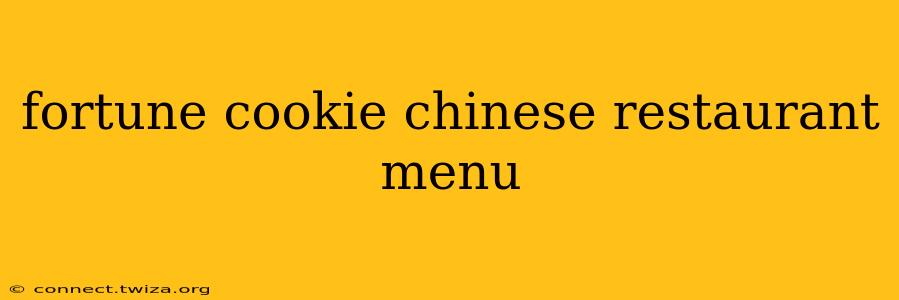The humble fortune cookie. A seemingly insignificant treat tucked into the takeout container, it's become inextricably linked with the Chinese restaurant experience in the West. But how much do we really know about this crispy, sweet, and often cryptic confection? This article delves into the fascinating history and cultural significance of the fortune cookie, exploring its place on the Chinese restaurant menu and addressing common questions surrounding this beloved culinary curiosity.
What is a Fortune Cookie?
A fortune cookie is a small, crisp, sweet cookie usually containing a small strip of paper with a fortune, proverb, or prediction printed on it. While often associated with Chinese cuisine, its origins are far from the Far East. The cookie's delicate, almost fragile texture, its simple, almost bland sweetness, and its mysterious message all contribute to its enduring charm.
Where Did Fortune Cookies Originate?
This is a common misconception. Contrary to popular belief, the fortune cookie is not a traditional Chinese food. Its origins are likely rooted in Japan, with some evidence pointing to its creation in the late 19th or early 20th century. It's believed they were initially served at Japanese tea houses. Their introduction to the United States, and subsequent association with Chinese restaurants, is a complex story involving immigration and cultural adaptation.
Are Fortune Cookies Part of Authentic Chinese Cuisine?
No, fortune cookies are not traditionally served in China. While they are a common sight in Chinese restaurants across the Western world, they hold no cultural significance in China itself. This demonstrates how food traditions can evolve and adapt across different cultures, sometimes leading to fascinating misattributions. The lack of fortune cookies in authentic Chinese restaurants is a key point to remember when considering the origins and spread of this dessert.
What Are Some Common Fortune Cookie Fortunes?
The messages found inside fortune cookies vary widely, ranging from generic inspirational quotes to more specific predictions. Common themes include love, luck, wealth, and health. While many are lighthearted and whimsical, some attempt to provide more profound reflections or pieces of advice. The seemingly random nature of the fortunes only adds to their appeal.
Why Are Fortune Cookies Served in Chinese Restaurants in the West?
The widespread adoption of fortune cookies in Western Chinese restaurants is a complex issue with no single definitive answer. Several theories exist, focusing on aspects of cultural exchange and marketing. The small, inexpensive treat likely served as a pleasant surprise for diners, increasing customer satisfaction and potentially encouraging repeat business. Over time, the fortune cookie became deeply entrenched in the Western perception of the "Chinese restaurant experience". Its ubiquitous presence highlights the cultural adaptation and sometimes misrepresentation of food traditions across different cultures.
How Are Fortune Cookies Made?
The process of making a fortune cookie is surprisingly simple. A thin, slightly sweet batter is poured onto a hot, round mold, quickly shaping the cookie before it sets. While a machine can help with mass production, skilled hands can still make excellent fortune cookies manually. The paper containing the fortune is carefully inserted during the last moments of baking, contributing to the charming irregularity of the final product.
The Enduring Appeal of the Fortune Cookie
The fortune cookie's enduring appeal lies in its unique combination of sensory experience and playful mystery. The crisp texture, the subtle sweetness, and the anticipation of unfolding a cryptic message create a memorable culinary ritual. While its origin and cultural significance are complex and sometimes misleading, it remains a cherished part of the dining experience for many, regardless of its true place within genuine Chinese gastronomy. Its continued presence on Western Chinese restaurant menus underlines the dynamic evolution of culinary traditions across borders.
